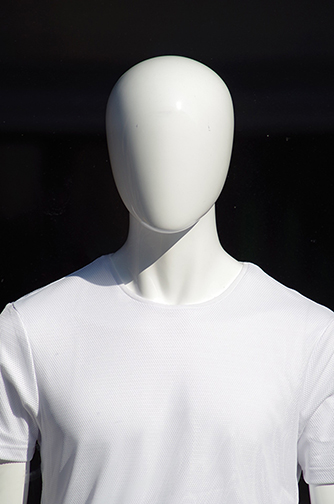I have been using mannequins in my artwork for a long time. As elements in sculpture or subjects of photography, they emanate a mysterious and eerie presence. Artificial, idealized and frozen in time, the creation of the mannequin had the sole purpose of serving us as pretend human beings. I love meandering through narrow passageways of a giant and dusty old warehouse, filled with piles and groupings of second-hand mannequins in various conditions, poses and states of dismemberment. Some facial expressions and body forms captivate me and they become fixtures in my studio, eventually making their way into an art piece I create.
One day in the near past, I came face to face with an unexpected discovery. I was in one of the most upscale malls in my home city for the first time in years. Since I rarely set foot into these temples of commercial delight, one could say I am somewhat out of touch with the latest changes in fashion trends. With guilty pleasure I was observing beautifully decorated storefronts, carefully and effectively designed to evoke the feeling of yearning.
Peeking through the windows, like a true voyeur, I felt myself succumbing to the lure of perfect lifestyle located just behind the glass, until… a jolt of new awareness woke me from my daze. Every clothing store displayed mannequins that had absolutely no identifying features. (Later, I found out the industry name – egghead mannequin). Indeed, the heads were elegantly shaped ovals. One of the variations in style had a mere suggestion of a nose protruding ever so slightly, as if a stocking was pulled over the head. In addition to the erasure of facial features, details in fingers and toes were also missing.
Naturally, once I noticed the pattern, I looked for other distinguishing features in the models which wore the glitziest fashion brands on the market. The materials used in their production also strayed as far as possible from the shades and textures of human skin. Highly polished and reflective plastic surfaces came in various colours, from metallic greys to bright blue, yellow and red. Some mannequins were made entirely out of canvas, their parts sewn together like dolls, making a bold statement of an environmentally responsible alternative. Not surprising, there was no hair anywhere in sight, and little indication of gender, other than clothing they were wearing.
I was dumbfounded not to encounter one model that looked like a traditional mannequin. Not only individual identities were missing in these forms, but humanity itself disappeared. I guess mannequins with personalities, with their flawed adherence to beauty and reality, are now a thing of the past. A generic, universal, stylish and nondescript look is in.
To make a poignant conclusion to this story, somewhere around the same time, I visited the aforementioned warehouse with recycled store displays. Walking through the narrow aisles, musty smell in the air, I stumbled upon a bunch of mannequin heads, severed from their bodies at the top of their necks, each one with a unique and alluring expression. When the proprietor solemnly informed me that heads with faces are no longer acceptable, I had an image of a guillotine very vividly arise in my mind. It’s a Revolution! He told me that apparently, the bodies of the outdated mannequins can be refurbished and glazed over with a contemporary look, but the heads have to go, they must be replaced with a new standard – a featureless, unremarkable (egg-shaped) form.
Ever since, the question has been nagging at me: if mannequins reflect current tastes and norms, what do egg-heads say about us?


I visit malls fairly often, but I never noticed this shift from mannequins with faces to egghead mannequins. But I do remember them having faces, and now come to think of it some of them don’t even have heads anymore. Mannequins are supposed to embody the ideal beauty standard, but beauty standards are always changing. Maybe the eggheads are better equipped to handle the change.
I think the mannequin does indeed embody the idealized beauty standard that is at once vague and indeterminate and yet gives possibility to the shopper to “see themselves” in the outfit being modelled. Your observation of the blurring of gender-types is dead on as in this time so-called gender norms are rapidly shifting and opening space for new definitions and identities – perhaps even mannequins can help in this regard -probably better than some people!
zp9o9a
8n47uy